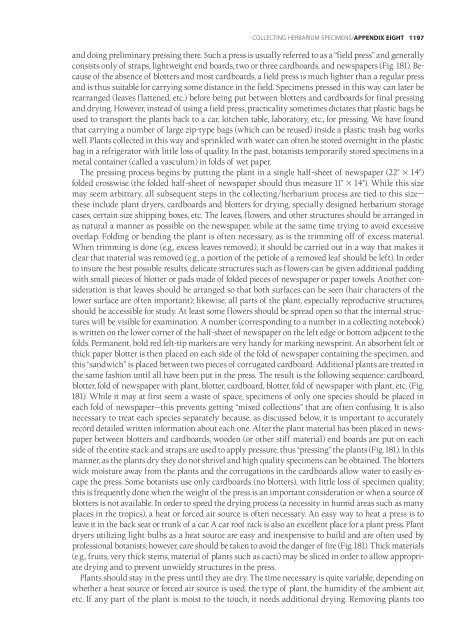Appendices & Glossary - Botanical Research Institute of Texas
Appendices & Glossary - Botanical Research Institute of Texas
Appendices & Glossary - Botanical Research Institute of Texas
You also want an ePaper? Increase the reach of your titles
YUMPU automatically turns print PDFs into web optimized ePapers that Google loves.
COLLECTING HERBARIUM SPECIMENS/APPENDIX EIGHT<br />
1197<br />
and doing preliminary pressing there. Such a press is usually referred to as a “field press” and generally<br />
consists only <strong>of</strong> straps, lightweight end boards, two or three cardboards, and newspapers (Fig. 181). Because<br />
<strong>of</strong> the absence <strong>of</strong> blotters and most cardboards, a field press is much lighter than a regular press<br />
and is thus suitable for carrying some distance in the field. Specimens pressed in this way can later be<br />
rearranged (leaves flattened, etc.) before being put between blotters and cardboards for final pressing<br />
and drying. However, instead <strong>of</strong> using a field press, practicality sometimes dictates that plastic bags be<br />
used to transport the plants back to a car, kitchen table, laboratory, etc., for pressing. We have found<br />
that carrying a number <strong>of</strong> large zip-type bags (which can be reused) inside a plastic trash bag works<br />
well. Plants collected in this way and sprinkled with water can <strong>of</strong>ten be stored overnight in the plastic<br />
bag in a refrigerator with little loss <strong>of</strong> quality. In the past, botanists temporarily stored specimens in a<br />
metal container (called a vasculum) in folds <strong>of</strong> wet paper.<br />
The pressing process begins by putting the plant in a single half-sheet <strong>of</strong> newspaper (22" 14")<br />
folded crosswise (the folded half-sheet <strong>of</strong> newspaper should thus measure 11" 14"). While this size<br />
may seem arbitrary, all subsequent steps in the collecting/herbarium process are tied to this size—<br />
these include plant dryers, cardboards and blotters for drying, specially designed herbarium storage<br />
cases, certain size shipping boxes, etc. The leaves, flowers, and other structures should be arranged in<br />
as natural a manner as possible on the newspaper, while at the same time trying to avoid excessive<br />
overlap. Folding or bending the plant is <strong>of</strong>ten necessary, as is the trimming <strong>of</strong>f <strong>of</strong> excess material.<br />
When trimming is done (e.g., excess leaves removed), it should be carried out in a way that makes it<br />
clear that material was removed (e.g., a portion <strong>of</strong> the petiole <strong>of</strong> a removed leaf should be left). In order<br />
to insure the best possible results, delicate structures such as flowers can be given additional padding<br />
with small pieces <strong>of</strong> blotter or pads made <strong>of</strong> folded pieces <strong>of</strong> newspaper or paper towels. Another consideration<br />
is that leaves should be arranged so that both surfaces can be seen (hair characters <strong>of</strong> the<br />
lower surface are <strong>of</strong>ten important); likewise, all parts <strong>of</strong> the plant, especially reproductive structures,<br />
should be accessible for study. At least some flowers should be spread open so that the internal structures<br />
will be visible for examination. A number (corresponding to a number in a collecting notebook)<br />
is written on the lower corner <strong>of</strong> the half-sheet <strong>of</strong> newspaper on the left edge or bottom adjacent to the<br />
folds. Permanent, bold red felt-tip markers are very handy for marking newsprint. An absorbent felt or<br />
thick paper blotter is then placed on each side <strong>of</strong> the fold <strong>of</strong> newspaper containing the specimen, and<br />
this “sandwich” is placed between two pieces <strong>of</strong> corrugated cardboard. Additional plants are treated in<br />
the same fashion until all have been put in the press. The result is the following sequence: cardboard,<br />
blotter, fold <strong>of</strong> newspaper with plant, blotter, cardboard, blotter, fold <strong>of</strong> newspaper with plant, etc. (Fig.<br />
181). While it may at first seem a waste <strong>of</strong> space, specimens <strong>of</strong> only one species should be placed in<br />
each fold <strong>of</strong> newspaper—this prevents getting “mixed collections” that are <strong>of</strong>ten confusing. It is also<br />
necessary to treat each species separately because, as discussed below, it is important to accurately<br />
record detailed written information about each one. After the plant material has been placed in newspaper<br />
between blotters and cardboards, wooden (or other stiff material) end boards are put on each<br />
side <strong>of</strong> the entire stack and straps are used to apply pressure, thus “pressing” the plants (Fig. 181). In this<br />
manner, as the plants dry they do not shrivel and high quality specimens can be obtained. The blotters<br />
wick moisture away from the plants and the corrugations in the cardboards allow water to easily escape<br />
the press. Some botanists use only cardboards (no blotters), with little loss <strong>of</strong> specimen quality;<br />
this is frequently done when the weight <strong>of</strong> the press is an important consideration or when a source <strong>of</strong><br />
blotters is not available. In order to speed the drying process (a necessity in humid areas such as many<br />
places in the tropics), a heat or forced air source is <strong>of</strong>ten necessary. An easy way to heat a press is to<br />
leave it in the back seat or trunk <strong>of</strong> a car. A car ro<strong>of</strong> rack is also an excellent place for a plant press. Plant<br />
dryers utilizing light bulbs as a heat source are easy and inexpensive to build and are <strong>of</strong>ten used by<br />
pr<strong>of</strong>essional botanists; however, care should be taken to avoid the danger <strong>of</strong> fire (Fig. 181). Thick materials<br />
(e.g., fruits, very thick stems, material <strong>of</strong> plants such as cacti) may be sliced in order to allow appropriate<br />
drying and to prevent unwieldy structures in the press.<br />
Plants should stay in the press until they are dry. The time necessary is quite variable, depending on<br />
whether a heat source or forced air source is used, the type <strong>of</strong> plant, the humidity <strong>of</strong> the ambient air,<br />
etc. If any part <strong>of</strong> the plant is moist to the touch, it needs additional drying. Removing plants too
















